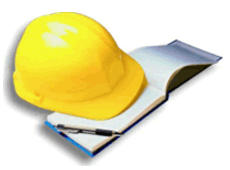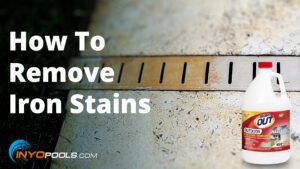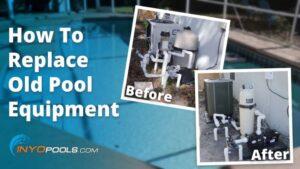Can I build my own pool? Yes, you can! Subcontracting the build of your own swimming pool is not rocket science. At INYOpools.com, we have seen a huge trend in homeowners building their own swimming pools. When most people think of building their own pool, they think that they would be like the professional pool contractor out digging the hole for the pool, doing the plumbing and electrical, etc.- but this is not the case. Most pool contractors do not do the actual labor of building the pool themselves. Pool builders act as general contractors (GC) and subcontract the building of the pool to various subcontractors (subs), so when you purchase a pool from your local pool company, they are organizing the build of your pool through subs.
The builder would arrange for a sub to dig the hole, another sub for the plumbing, another for the electrical and so on. Essentially, the act of building a pool is really just the act of assembling the proper subcontractors to build the pool for you. What kind of savings can you expect to see by doing all the legwork yourself? The savings are substantial – expect to save in the neighborhood of $10,000 to $15,000! Below are quotes from 4 different pool builders for the same pool, followed by the Homeowner Builder price:
Pool Builder #1 – $50,245
Pool Builder #2 – $45,950
Pool Builder #3 – $50,438
Pool Builder #4 – $48,105
Homeowner Builder – $35,416
As you can see, there is an advantage to doing this yourself!
When talking with our customers, we find out that many are amazed at the increased cost of a new pool and that you do not get much pool for the money. As the GC of your own pool, you can add many of the upgrades to your pool that you would not be able to afford through a pool builder. Many times the cost of the pool with all of the upgrades is less than the builder’s price with the standard equipment and features. Once again, as the GC of your pool, you are not actually building the pool, and you do not have to be a professional in any of the individual components that make up pool building. As the GC, you will be responsible for hiring the different subs who are professionals in their trade. It is always a good idea to read up on the process of building a pool as well as research the individual phases of building the pool, so you are as well versed as possible when you interview or hire your different subcontractors to build your pool. As a GC, your main responsibility will be scheduling the different subs to build the pool, so it will be imperative that you know the process in which the subs should be scheduled. Some good questions to ask yourself before you make the decision to build a swimming pool are as follows:
1. Planning & Design
Is the first thing you will want to consider before constructing your pool. We have listed several important questions to ask during the Pool Design phase.
We have listed several important questions to ask during the Pool Design phase.
- What is your budget?
- Where in the yard will the pool be located?
- What is the primary use of the pool?
- What shape will it be?
2. Contact potential subcontractors
To bid on your pool. This process will also help you determine the work order of the subcontractors. We have found that finding the first subs for your pool build is one of the most difficult phases of the pool build. Some recommendations for finding your first subs would be to look through the local Yellow Pages, contact friends who have  built their own pool or visit the local pool supply store. Once you have contacted your first sub it will now be easier to locate additional subs. For example, let’s say the first sub you contacted was a layout sub. Once you have finished talking with this sub you would want to ask them if they could recommend a plumbing or electrical sub.
built their own pool or visit the local pool supply store. Once you have contacted your first sub it will now be easier to locate additional subs. For example, let’s say the first sub you contacted was a layout sub. Once you have finished talking with this sub you would want to ask them if they could recommend a plumbing or electrical sub.
Do you work with Homeowner Builders? If not, can you recommend a sub who does?You now would call the recommended plumbing or electrical sub and once again when you have finished talking with them you would want to ask for recommendations on additional subs. When contacting a Sub Contractor you should ask the following questions:
- What part of the pool building process are you responsible for?
- What does the complete job encompass?
- Do you require anything from me before you start your work?
- What materials/equipment do you supply?
- Is there anything you are expecting me to provide?
- Am I responsible for picking up any material or equipment or will you be bringing all the equipment/materials?
- Which phase of the pool building process do you usually come in on?
- Which subs comes before you and which subs comes after you? Also, can you provide a run down of the sequence of all subs for the pool building process?
- How do you get paid?
- When do you get paid?
- Is there a discount for cash payments?
- Will you sign this informal contract detailing all the work that you are planning to do and when you plan on completing it by?
- Can I bring in an independent inspector to check your work when you’re done?
- Do you do this special feature?
After asking the sub the above questions you will want to FAX the sub a copy of your pool design and ask them to bid on your project. You may also want to ask the sub for any input on your design, if they think any areas may have issues or many not meet code. For a typical gunite pool build the subs would be scheduled as listed below. Vinyl and Fiberglass pools are slightly different, so we will outline any differences in there process at the end of this section.
Gunite Pools
Planning & Pool Design – This is the first step in the pool building process and many homeowner builders undertake this task themselves. There is much pool design software on the market including AutoCad and Adobe, as well as many online pool design solutions. The sub you choose will probably have seen pool drawings done in just about any format from pencil sketches to detailed computer drawings. We would suggest doing your design through a software program as it will eliminate confusion with the subs. If you do not feel comfortable doing your own pool design, there are many companies that can help in this phase including http://www.pooleng.com/ , http://www.pooltemplates.com/ , http://pooldesignsoftware.com/ http://www.poolspaworld.com/.
Structural Engineering – responsible for drawing up the engineering drawings that determine the stress forces throughout your pool. They take into account pool depths, proximity to property lines and house lines. The structural engineering drawings will determine how much steel rebar is necessary to support the pool. We recommend doing your structural engineering drawings with http://www.pooleng.com/.
City Permits – Most cities require that you fill out an application along with your structural drawings. The city will review the plans and request any corrections required by the Codes to be made. Typically A swimming pool permit issued by your city or county is required prior to starting any work on your pool.
Call Before you Dig / Blue Stake – This service is typically free and gets your underground utility lines marked and helps prevent undesired consequences like broken gas or plumbing lines.
Layout – Draws the shape of the pool on the ground that excavators will use to dig the hole.
Excavation – responsible for digging the hole where your pool will be. Most excavators use a backhoe, but in projects with limited access, a Bobcat may be used. In extreme cases, they will come in with a large crew to do a hand dig. The excavators will form the steps, benches, and other structural features in your pool such as a beach entry.
Plumbing – responsible for installing all PVC piping and pool equipment required for pool filtration. The pool equipment includes pumps, filters, heaters, chlorination systems, and cleaning systems. It is important to let the plumber know that you will be providing all of your own equipment as this is an area where you may save a lot of $$$$. The equipment that you will need for the plumbing phase is Main Drains, Skimmers, Pool Pump, Pool Filter, Pool Heater, Pool Chlorinator, Eyeball Fittings, Wall Fittings, Water Leveler, Pool Waterfalls, Jandy Valves, Spa Blower & Spa Jets
For more information on choosing the proper pool filter For more information on choosing the proper pool heater For more information on alternatives to chlorine For more information on pool plumbing diagrams
Gas – If you are building a pool or spa that uses a natural-gas heater, or other features which use Natural Gas you will need to contact a Gas company. They will put in all the natural gas lines needed for this equipment. In some states, the gas work requires a separate permit and inspection. Normally the gas sub will take of this as a part of the job they do.
Electrical – The electrician lays the electrical lines that will operate your pumps, timers, remotes, and pool/spa lights. The electrician can also add as much extra electrical work as you need for your overall backyard project. The equipment needed prior to the electrical phase will be pool light niches, pool controls and swimming pool lighting
For more information on choosing the proper swimming pool controls
For more information on choosing the proper swimming pool lights
Steel – responsible for laying down the steel rebar frame that forms the reinforcement for your pool shell before the shotcrete is shot.
Shotcrete – responsible for forming the shell of your pool. Shotcrete is a mixture of concrete and other materials that is sprayed on using a high-pressure nozzle to form a hardened shell.
Rockwork (Optional) – responsible for any rock water features in and around the pool prior to the deck being poured. This includes standard waterfalls, grottos, and accent boulders around the perimeter of the pool.
Deck – responsible for the decking area around the pool. Kooldeck has been the standard for years, but more recently, Acrylic decking is getting popular as it can be applied in a variety of different finishes and it is more durable. Flagstone, Pavers, Travertine, and other exotic stones are being used in new creative applications.
Tile – responsible for installing the tile inside the pool and along the waterline of the pool.
Fence or Screen Enclosure – responsible for installing the fencing around the perimeter of the pool that is required to meet code in most cities. In most cases, this is a standard aluminum fence. In warmer climates many people will opt for a screen enclosure instead of a fence.
Cleanup – after the shotcrete, rockwork, deck work, and tile work are done, the pool will be quite a mess. Cleanup is responsible for hauling away all the trash before the interior of the pool is installed. They also do the final grading (or regrading) of the land around the pool (if possible), since it will have been torn up pretty badly by all the other prior subs. They also make sure the deck, pool lights, and all the peripheral areas are cleaned up before final interior.
Interior / Marcite – responsible for installing the interior finish of the pool. Standard marcite plaster has been the interior of choice for years, but that is giving way to a new generation of advanced interior products. Exposed aggregate pebble interiors (like Pebble-Tec, Baja Pebble, or SunStone) are getting popular now. Just in the Pebble arena, there are many variations like Pebble-Sheen (from Pebble-Tec that uses smaller, smoother stones which are gentler on skin), Pebble Smooth (from Baja Pebble that actually grinds and polishes the exposed stones to a mirror-like tile finish), or what is considered the top-of-the-line marble-like finish Hydrazzo by Aquavations. Quartz is also getting popular with a variety of different brands available – Colorquartz/3M, Diamond Brite/SGM, and Krystal-Krete/CLI.
Acid Wash – this is done by the interior subs as a part of the overall work to clean away the surface plaster haze from the finish after the pool interior has had time to dry.
Startup – responsible for giving you all the tools and startup chemicals needed to get you going along with some introductory instructions on pool startup and maintenance. We would suggest purchasing a Chemical Start Up Kit which includes all of the proper chemicals to start up and maintain your pool as well as New Pool maintenance kit which includes all of the items need to clean your pool on a regular basis.
City / County Inspection – After completion of your pool build, he county / city will come out to the final inspection of your pool.
Above we have outlined the process of building a Gunite Pool, which is the most popular style of pool. There are two other types of pools, though Vinyl & Fiberglass. The building process for vinyl and fiberglass pools is the same as a gunite pool except where we have noted below:
There are three types of inground pools: fiberglass, vinyl, and concrete. Each needs a pump, filter, drains, returns, plastic piping, and chemical feeder. Fiberglass pools are noted for their relatively quick installation, non-abrasive finish that resists staining, and inert composition that inhibits algae formation. Fiberglass pools are manufactured in a variety of shapes. The one you choose will arrive pre-formed in one piece. Because it is delivered to your site and needs to be dropped into place by a crane, access to the backyard area must be available. Once the pool is in place and leveled, heating, filtration, and other systems are set up. The crew then backfills the site and fills the pool with water. If you choose fiberglass, you’ll want to compare the materials used, production methods, and warranties.
Vinyl Liner Pools
Known for their smooth, stain-resistant surface, and usually come as packages. Design options may be limited, but they are typically less expensive than fiberglass and gunite pools. Depending on the soil composition, once the excavation is complete, a wall system is constructed of wood, poured concrete, steel, and aluminum or polymer. The bottom material might be of packed sand that is free of stones or poured concrete. Once the vinyl liner is installed, and systems are set up, the site is backfilled, and the pool is filled with water. Liners may have to be replaced about every ten years, depending on usage and location.
3. Selecting the Subcontractors
It is now time to choose the subs that will be building your pool. Below we have listed a guide to help you choose the proper subs for the job:
- Must be licensed, bonded, and insured. This is the single most important thing you can do when you hire a sub. If you insist that all your subs are licensed, you will have taken the single most important step in minimizing a number of headaches you will encounter during the pool project and in the years to follow. Getting subs who are licensed, bonded and insured puts a lot of safety mechanisms on your project to protect you from getting scammed. You can go to the Registrar of Contractors (ROC) in your state to find out this information. Using a licensed and bonded sub allows you to file a complaint with the Registrar of Contractors to get compensation should they mess up badly. You can file a claim with the state to recover your loss if something should go terribly wrong. You can file a claim up to 2 years after you detect a problem in the workmanship of the sub’s product. They will arbitrate cases and will suspend a subs license if they determine that the sub is at fault, and they are not responding to the problem. When a sub’s license is suspended, they can’t work, and that’s exactly the kind of leverage you want. Being licensed with the ROC also guarantees that the work that they do is warrantied for two years. The “insured” part is to guarantee that you are not held liable if one of the crew from your subs gets injured.
- Must have a clean record with the ROC. Your state ROC website is great for this. You may find out who has outstanding complaints against them, how many, how many were closed and which are still outstanding.
- Must be reputable in their trade – You should be able to get references and referrals from others who have used the sub. Ask other pool owners who GC’ed their pool and ask them for recommendations. Ask other subs about subs they would recommend.
- Must have a minimum amount of experience in that trade and in the pool industry. The subs should have at least a year or two of industry experience. As a first cut, go to the RoC website to see how long they’ve had their license. This will give you a rough estimate of how long they’ve been in the trade. A few good questions to ask your subs would be how long they’ve been working on pools and if they currently work for any of the major pool builders. If they are currently working with pool builders, ask them how many pools they do a year or have done since they started. Ask them how many pools they’ve done in your city. This is helpful because it identifies who has experience with the codes and regulations for your city, which may be different in the next city.
- Understand that you are not a pool expert – because of this fact, you will need to lean heavily on your subs to explain things to you. Get the best. You will be light years ahead of the game by going with subs who have done thousands of pool in their lifetime.
4. Collect Bids from the Subcontractors That Made the Cut
Fax copies of your pool design to subs. Call the sub first on the phone to speak with them in person and explain that you are a homeowner wanting to build a pool on your own and ask if they work directly with home owners. Almost all subs will work with homeowners. In actuality, most subs would rather work with homeowners because they get paid quicker. As you have them on the phone, you will be able to get the information listed in step 4 above. For the bid make sure they include the following:
- Line-itemization of all the parts or equipment they will use, and a detailed list of work charges if applicable.
- Warranties and what things are warrantied separately from the standard two years.
- What is the cash price (usually they will give you a 5% discount for cash payment)?
Ask the sub to let you know what they need from you info-wise to include in the FAX. After that, fax them the drawing and wait for the bid to be FAXed back. Whatever is missing from the drawing must be added to the FAX cover sheet. Make sure to got bids from multiple subs from each trade, most of the time, try to get at least three. This insures that a particular sub is not over-charging you. Most of the subs in our example came within 10% of each other. Having a line itemization helps because then you can compare the quote line by line to see where the discrepancies are.
5. Making the Final Subcontractor Selection
Believe it or not, this is typically the hardest part in the process. If the bids come out over $500 different (, and you determine that all else is equal – i.e.,. reputable, multiple referrals, a clean record at ROC, etc.), you should just go with the less costly bid. Some extenuating circumstances will make you go with the higher priced bid. For example, when choosing excavators, if you continue to hear the name of a sub being mentioned over and over again by others and you are told they are simply the best then it may be a good idea to splurge the extra $$.
Listed below are typical equipment lists for Pool only builds, and Pool & Spa builds. We have listed a standard equipment package that would be the most basic equipment, and we have also listed an upgraded equipment package that includes upgraded equipment.
Standard POOL ONLY Equipment List
Swimming Pool Pumps
Swimming Pool Filters
Pool Chlorinator
Wall fittings (different for vinyl)
Eyeball fittings
Anti-Vortex Main Drain (different for vinyl)
Swimming Pool Lighting (Voltage)
Intermatic Transformers (if 12V)
Pool Light Niche (different for vinyl)
Letro Auto Fill
Jandy Valves
Hayward Skimmers (different for vinyl)
Intermatic Timers
Standard Maintenance Kit
Pool Chemical Start Up Kit
Standard POOL & SPA Equipment List
Swimming Pool Pumps
Spa Pumps
Pool & Spa Heater
Swimming Pool Filters
Spa Jets
Spa Jet Internals
Spa Blower
Wall fittings (different for vinyl)
Eyeball fittings
Anti-Vortex Main Drain (different for vinyl)
Swimming Pool Lighting (Voltage)
Spa Lighting
Intermatic Transformers if 12V
Pool Light Niche (different for vinyl)
Spa Light Niche
Letro Auto Fill
Jandy Valves
Hayward Skimmers (different for vinyl)
Intermatic Timers
Pool Chlorinator
Standard Maintenance Kit
Pool Chemical Start Up Kit
Add on options & upgrades
Pool Heaters / Swimming Pool Heat Pump / Solar Pool Heating
Pool Controls
Salt Chlorine Generator & Pool Alternative Sanitizers
Automatic Pool Cleaners
Fiber Optics
LED Pool and Spa Lights
Pool Waterfalls
Diving Boards
Swimming Pool Slide
Ladder & Rails
Swimming Pool Covers
Pool Alarms
Inyo’s Suggested equipment List for POOL ONLY Builds
Inyo’s Suggested equipment List for POOL & SPA Combinations
|
By following the steps above you are on your way to saving tens of thousands of dollars building your own pool. INYOpools.com can supply you with all of your equipment to build your pool including: pumps, filters, controls, heaters, lights and much more. We hope this guide will help you start your endeveavour of building your own pool. If you have any questions regarding the pool building process or necessary pool equipment please give us a call toll free at 1-877-372-6038.













Leave a Reply